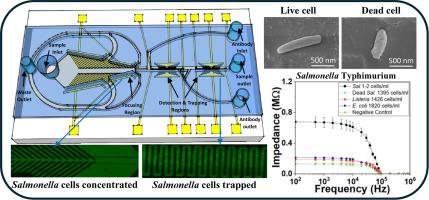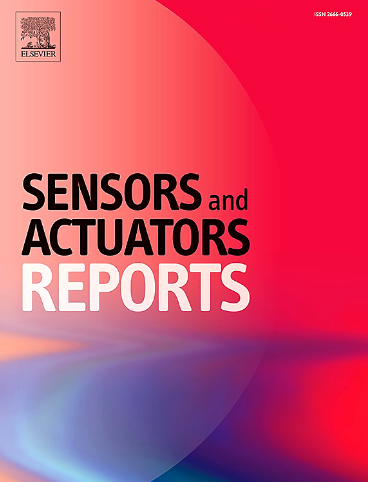用于快速准确检测生鸡肉产品中沙门氏菌的高灵敏度微流控生物传感器
IF 7.6
Q1 BIOTECHNOLOGY & APPLIED MICROBIOLOGY
引用次数: 0
摘要
本文研究了一种基于流体的阻抗生物传感器,用于快速准确地检测生鸡屠体冲洗液中的鼠伤寒沙门氏菌。该生物传感器设计了多个不同的区域,可将沙门氏菌抗原浓缩到可检测的水平,然后将浓缩的沙门氏菌样本捕获到涂有特异性沙门氏菌抗体的检测电极阵列上,从而最大限度地增加捕获抗原的数量。检测是通过抗体与抗原的结合过程实现的,结合事件会改变阻抗值,从而为识别和量化沙门氏菌提供了一种可靠的方法。该生物传感器的检测限(LOD)较低,40-50 分钟内可检测到 1-2 个细胞/毫升。研究结果表明,即使存在高浓度的沙门氏菌死细胞,该生物传感器也能区分低浓度的活沙门氏菌细胞和非特异性结合病原体,即李斯特菌和大肠杆菌 O157:H7。本文章由计算机程序翻译,如有差异,请以英文原文为准。

A highly sensitive microfluidic biosensor for rapid and accurate detection of Salmonella in raw chicken products
This paper presents an investigation of a fluidic-based impedance biosensor for rapid and accurate detection of Salmonella Typhimurium in raw chicken carcass rinsate. The biosensor is engineered with multiple distinct regions that concentrates Salmonella antigens to a detectable level, subsequently trapping the concentrated Salmonella samples on top of the detection interdigitated electrode array coated with a specific Salmonella antibody, maximizing the number of captured antigens. Detection is achieved through the antibody-antigen binding process, where binding events changes impedance values, providing a reliable method for identifying and quantifying Salmonella. The biosensor demonstrated a low limit of detection (LOD) of 1–2 cells/ml within 40–50 min. The findings demonstrated that the biosensor distinguishes low concentrations of live Salmonella cells, even in the presence of high concentrations of dead Salmonella cells, and non-specific binding pathogens viz., Listeria monocytogenes and E. coli O157:H7.
求助全文
通过发布文献求助,成功后即可免费获取论文全文。
去求助
来源期刊

Sensors and Actuators Reports
Multiple-
CiteScore
9.60
自引率
0.00%
发文量
60
审稿时长
49 days
期刊介绍:
Sensors and Actuators Reports is a peer-reviewed open access journal launched out from the Sensors and Actuators journal family. Sensors and Actuators Reports is dedicated to publishing new and original works in the field of all type of sensors and actuators, including bio-, chemical-, physical-, and nano- sensors and actuators, which demonstrates significant progress beyond the current state of the art. The journal regularly publishes original research papers, reviews, and short communications.
For research papers and short communications, the journal aims to publish the new and original work supported by experimental results and as such purely theoretical works are not accepted.
 求助内容:
求助内容: 应助结果提醒方式:
应助结果提醒方式:


